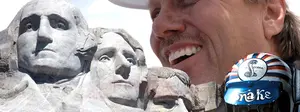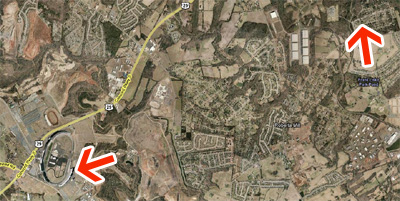

A vividly imagined column
I spent some enjoyable time with Billy Meyer at Texas Motorplex during the O'Reilly Super Start Batteries NHRA Fall Nationals presented by Castrol Syntec, listening to him spin tales about his career that I was all set to share with you here today, but I was beaten to the punch by Bobby Bennett, who wrote up a nice story on "Waco Willie's" career for his site, so I'll switch gears in a second.
Meyer is definitely one of drag racing's greatest success stories, and not solely based on his track time. At one time, he owned one of the highest winning percentages in final rounds (everyone including John Force [62.3 percent] is still chasing Don Prudhomme's 74.4 percent mark [35-12]), and today, he owns seven businesses, in areas ranging from airplane sales to building restoration. One of his companies just took on the task of repairing more than 20 La Quinta motels damaged by Hurricane Ike.
So, as Billy's dad, Paul, used to preach, "Whatever you vividly imagine, ardently desire, sincerely believe, and enthusiastically act upon must inevitably come to pass," I'm imagining a column that I ardently desire to be interesting and that I sincerely believe I can write, which I now will enthusiastically act upon.

I wanted to share a great bit of writing about drag racing, inspired by the recent NHRA Carolinas Nationals.
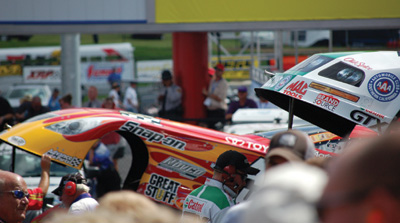 |
"Anticipation and adrenaline combine to create a heady euphoria in the congregation that has assembled to witness this sermon of speed. The sleek, logo-brazen cars, if you could call them that, are really only slight approximations of what we know an automobile to be. These hulking marvels of modern engineering take on a cartoonish quality as they pose under the
"With laser precision, the velocity monsters align themselves shoulder to shoulder at the speedway's altar, waiting impatiently for the Tree to blink its eyes from amber to green. Like an angry caged animal, they snort, pop, and spit raw fuel over the very crew, who just an hour prior performed successful open-heart surgery on them. The burning stacks of exhaust cry out in anticipation of the coming mayhem, and in the split second before all hell breaks loose, an eerie calm descends over the arena. The cars seem to take one last chest-raising, gonna-kick-your-ass breath before they explode in a violent cacophony of torqued steel and atmosphere-bending heat. The pair jump off the line, and 16,000 ear-shattering horses begin their ritualistic quarter-mile journey.
"Then, instantly, seemingly without warning, they are upon you. Like being too close to a lightning strike, you don’t know whether to duck for cover, [mess] your pants, or scream as if you just saw a ghost, which you do involuntarily as your brain tries to catch up with what just happened. You are rocked to the core with jaw-dropping, heavy-metal-Metallica, double-bass foot-pedal rumble — hell, yeah! You join the fanatic chorus of 30,000 other drag racing disciples, who simultaneously raise their hands and cans in a salute to unbridled horsepower and to life itself. There’s no mistaking it — you are alive — there is no forgetting it — you never will.
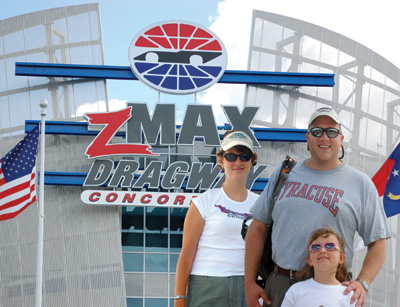 |
"In a little over three seconds, the flash of mechanical fury is complete. Nothing left but two chutes dancing through the blurry haze of hot
Written by a professional motorsports journalist? Nope (but I wish I could have written it).
It was authored by Todd Serdula, a

|
|
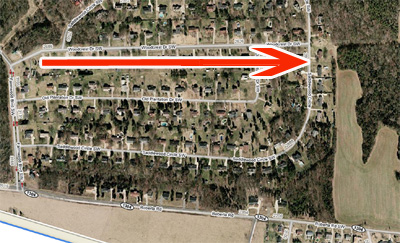 |
Speaking of
"The old
The old track is, by my Google Maps reckoning, about 3.5 miles northeast of zMax Dragway. If you take Roberta Church Road SW off of the Concord Parkway S(29) and go about a mile and a half, then hang a left on Roberta Roadand follow it about a mile, you'll reach Farmwood Boulevard SW. If you. hang a left, you'll be on the entrance road that so many fans followed four decades ago. When you get to Woodcrest, hang a right, and you're on the old track. Although Woodcrest runs just more than a quarter-mile (shown here with the red arrow) before it runs into Sandalwood Circle, make no passes, please. Past Sandalwood, you can see where the cars had plenty of runoff area in the old days. Google Street View hasn't yet (if it ever will) mapped this far-flung community or I'd give you a grounds-eye view.
In addition to Ivo, Garland said the track played host to the likes of Jack Chrisman, who held the track speed record, and Don Garlits, who was still recovering from his fire in Chester, S.C., and had Art Malone behind the wheel.
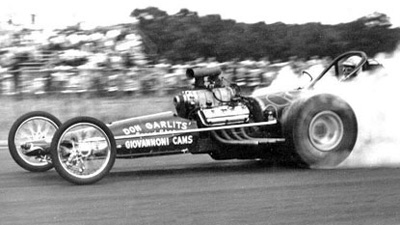 |
"When Garlits arrived in town, I met him and his family for lunch and a trip out to the strip," recalled
"He got there Saturday morning about 9 o'clock. I had stubbed up the wiring, hand-poured sack concrete, and smoothed it out about 2 in the morning. I got about two hours of sleep before building a set of lights and a spare set, then wired the plugs, and we tested the timing equipment about 2 o'clock Saturday afternoon. It worked the first try. Malone made a soft run through before the crowd started filing in.
"The amazing thing was that Ivo and Chrisman ran their exhibition runs without even questioning those big four-inch steel pipes and 75-pound metal housings right in the middle of the strip. Jack only said something about how he would make sure to stay away from the centerline."

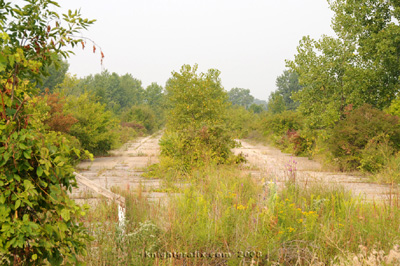 |
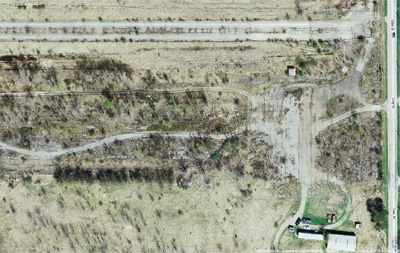 |
On the subject of dear old departed dragstrips, I got the photo at right from Billy Knight, a talented graphic artist and writer who helps Cory Mac with his blog photos and the writing of the text.
Knight was on his way to Indy and stopped off at the location of the fabled U.S. 30 Drag Strip --“Where The Great Ones Run!”
I'd always heard the track was in
Knight snapped this picture that shows the track well-overgrown with flora and fauna, although you can still clearly see both lanes.
"I took a walk down what was left of the track," he said. "I couldn't believe it. I felt like I went to visit an elderly friend and found out that he had died a slow, lonely death. This is where I saw guys like 'Jungle Jim,' 'Wild Willie' Borsch, 'Big Daddy,' 'T.V. Tommy' Ivo, Pat Foster, Shirl Greer, Frank Bradley, Jerry Ruth, Kenny Safford, Dick LaHaie, and Jeb Allen."
According to what I could dig up, the track opened in the mid-1950s just east of I-65 on the north side of U.S. 30 and closed in 1984.
Looking at this Google Maps image, obviously captured from deep space a few years ago, you can clearly see the two-lane track at the top of the image. The pits were south (below in this pic) of the track and spectator parking to the north.
You can find a really nice description of the track, a bit of its history, and even more photos of the forgotten 1,320 – albeit snapped more than seven years ago – on the Lost Indiana Web site. According to the site, the demise of U.S. 30 began after AHRA founder Jim Tice's death in 1982. His widow, Ruth, sold the sanctioning body two years later, and several strips, including U.S. 30, left the fold to join the ADRA. AHRA got into financial trouble after a disastrous 1984 World Finals at a new supertrack in
Without the drawing and marketing power of
I live within five sad miles of the site of the original Irwindale track, and at least the new owners are doing something worthwhile: brewing beer.

 |
Drag racing has had a lot of pioneers, from Don Garlits to Don Nicholson to Don Prudhomme, but I'd like to take a moment to remember a pioneer you may not have known, Mike Hollander, who passed away just after midnight Tuesday after a short but brave battle with mesothelioma, a form of cancer.
Although someone surely would have "invented" it years later, Hollander is the father of online race reporting and was in the business well before there was ever a publicly available World Wide Web.
Hollander began working his magic way back in the late 1970s and 1980s with the old CompuServe system. He developed a style and a method for covering the events, then leaned on the capable and broad shoulders of guys like the late Ed Dykes and the still-alive-and-coding Larry Sullivan and a cadre of devoted reporters like current FastNews honcho Rick Green to carry it forward.
I got involved with them in 1997, early in the life of NHRA.com, when the outfit was known as Racing Information Systems. We were their first big customer, and it took off from there. It became FastNews the next year, led by Dykes, and consisted largely of him, Sullivan, and Green, and a large cast of guest reporters.
Throughout the years, the style and content has grown and changed, but deep down in its core, the results still bear the DNA of Mike Hollander.
He was into a lot of things, from writing car books to working with the American Auto Racing Writers & Broadcasters Association and the Motor Press Guild. He won a lot of awards, including being named one of the 10 Most Influential Journalists in Motorsports by RACER magazine, and deservedly so. Most recently, he worked with
I chatted with Mike by e-mail earlier this year, and he was optimistic about his chances, but, in the end, it took away a pioneer of a different sort from the sport.
His good friend, all-around publicist guy, Doug Stokes, wrote, "Michael Hollander was a true leader, a gentle Pied Piper of the computer revolution, the guy who led a whole lot of us hot-shot journos directly into the wired-in future with both style and patience. His contribution to motorsports is immeasurable; his legacy is lived by all of us, every day.
"It was hard to see such an animated character get cut down the way it happened to Mike. His complaints were few; his courage was beautiful."
He asked for comments from those of us who knew him so that some might be read at his memorial later today. Here is mine:
I am forever indebted to Michael Hollander for pioneering the online results reporting from NHRA national events, a format that exists, in part, to this day on NHRA.com and allows people from all over the world to follow along with the results from the NHRA series. The work that he pioneered and the people with which he aligned himself, including the late, great Ed Dykes, Larry Sullivan, and Rick Green, have made my job so much easier and the world of NHRA fans that much wider.
Godspeed, Mike, and thanks.



















































